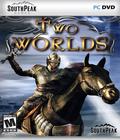Genre: RPG
Publisher: Southpeak Interactive
Developer: Reality Pump
Release Date: May 2007
It's hard to look at Two Worlds and not immediately think of Oblivion. The general graphical style is quite similar, and a lot of the features sound pretty similar, too. The difference lies in the two games' origins: While Oblivion was the latest in the big-budget Elder Scrolls series, Two Worlds is the product of a practically unknown Polish developer called Reality Pump. Despite Reality Pump's relative obscurity, they still have a reputation for turning out solid PC games like Earth 2160 and World War III: Black Gold. By comparison, Two Worlds is an incredibly ambitious project, full of ideas that blur the lines between online and offline RPG gameplay. Instead of simply a game in the vein of Fable, where you control your character's development, Two Worlds hopes to give players the chance to control the nature of the very world they're exploring.
Two Worlds is the very epitome of the Western approach to RPGs, featuring a skill-based character development system that lets players customize their character in a way that reflects their own personal approach in the game. Single-player characters tend to be human warrior types due to the story constraints of the campaign. The single-player mode calls for the player to be a human mercenary searching for a sister who disappeared in a mysterious attack, but that is, of course, just part of a much larger and more epic struggle. The massively multiplayer online mode allows players to generate any sort of specialized character that their heart desires, drawing from a pool of typical fantasy races. In multiplayer mode, players are encouraged to band together to exploit unique strengths and minimize weaknesses.
For instance, players can opt to have their character learn magic in exchange for specializing less in swordplay in the single-player game, but can create a full-fledged traditional magic user in the multiplayer online campaign. Skills of various sorts are taught by the game's Guilds, which reward completed quests with skill points. The game starts with two guilds, Fighters and Mages, and finishing the right quests can let players add in a third, the Necromancers. By focusing on physical skills, players can develop a skill from primitive form to far more powerful ones, and reallocate whenever necessary. For instance, let's say you teach your warrior how to ride a horse, but nothing more. Later, you realize you'd really like for her to be able to fight while on horseback, too, but you've spent your skill points on other special moves. Simply pull the points off the attack pool, reinvest them in the horsemanship pool, and voila! You have the mounted attacker you want just when you need her.
The actual spell system players use to learn magic is very unusual, almost more like something you'd find in a Japanese RPG or a Roguelike. Players learn magic by acquiring Spell Cards, which can be treated as components of a wide variety of spells. Let's say you find a Fireball Spell Card, for instance; you can use it to cast a weak fireball. Later, you may find an additional Fireball Spell Card. In many games, this would be junk, but not in Two Worlds. Instead, you could stack the two cards together, and so gain the ability to cast a Fireball that is twice as powerful. This means that no spell you learn in Two Worlds runs the risk of becoming useless as the game progresses. If a spell is no longer effective against enemies in a particular area, players are free to recombine their Spell Cards into a different spell, or to go out and acquire new ones in order to power up existing spells. When the game begins, players construct their spells using Wind, Fire, Water, and Earth cards in various combinations. If players finish the right quests, they can add a fifth element into the game's spell system, Necromancy.
The online/multiplayer aspect of Two Worlds is curiously old-school. It is very reminiscent of Diablo II, combining a single-player campaign with an online campaign. Unlike Diablo, though, Two Worlds in its multiplayer form is going to be a massive game, complete with a persistent world. Once you join a server, you'll launch into a city and have the opportunity to interact with thousands of players, although you can group up with seven others to solve quests together. For the time being, Two Worlds is not cross-platform compatible, although it's possible that in the future, Windows Vista and Xbox 360 users can join together in a game via Live Anywhere and Xbox Live, respectively.
How the multiplayer and single-player campaigns will interact is a bit up in the air, but it appears that the two campaigns will be completely separate for now. It's a "best of both worlds" approach to RPG design that few games have attempted, and it'll be interesting to see how it pans out. If this feature proves popular in Two Worlds, then it could easily become standard. Certainly having both a single- and multiplayer mode would seem to broaden an RPG's appeal, if the two modes could somehow be balanced against each other while using a single engine.
Both modes ask players to make choices about more than just what kind of gear they'll use or which skills they'll learn. The core idea of Two Worlds is to let the decisions made by players have a tangible effect on the world around them. An example shown to us was relatively simple, featuring a horde of orcs massing to attack a human city. You might gain prestige with the humans by helping them fight off the orcs. Alternatively, you could make a deal with the orcs, get inside the town, and open the gates for them. Then, when the settlement becomes an orc city, you'll be treated as an honored guest, and gain reputation with other orc settlements around the world (while humans will take a much dimmer view of you). Finally, you can opt not to get involved at all, and simply let events play out as they will. This "play it safe" approach doesn't gain you particular standing with any particular group, but also keeps any particular group from hating you. What decisions you make in turn affect what kind of resources you can obtain, and what kind of character you can build.
It's hard to judge Two Worlds's graphics based on the demo build Southpeak Interactive had to display, since even the PR agent admitted that it was massively unfinished. At the time, many importance graphics features simply weren't implemented yet. Some models were still incomplete (horses, notably, did not yet have manes or tails). What is interesting is the assurances from Southpeak's representative that within a month, the game would look completely different. Reality Pump's European development team is building the game in modular fashion, implementing sweeping refinements with every new build as new visual and gameplay components are finished. So, even though the game was alarmingly unpolished when viewed, Southpeak assured me that the game's visuals would be on a whole different level within a few weeks. I dutifully waited, and amazingly, this assertion turned out to be true.
The current iteration of Two Worlds looks amazingly complete, meriting comparisons to titles like Gothic 3 and Oblivion. Two Worlds is significantly rougher than those AAA titles right now, but also has surprisingly light system requirements given the level of performance it's reaching. So not only is it a beautiful game in the making, but very likely a beautiful game that even players who own mid-range gaming computers can potentially play. I can't emphasize enough how rare it is for a publisher's promises of "It'll look completely different in a month!" to actually have meaning in this industry, and it hints that Two Worlds may be an unexpected gem in the making.
Even with its May release two months away, there are still a lot of details that remain in the air with Two Worlds. Details about the MMO mode are scarce, and all that's known about the soundtrack is that it'll be provided by the same composer who scored the classic '80s action film, "Top Gun." It's hard to predict what the final build of the game will look like, and Reality Pump's modular building process could very well open the software up to a variety of potential bugs and programming errors. While much as been made of the ability to alter the world through decision-making via simple examples, exactly how extensive and complex those changes can become also remains to be seen. Still, Two Worlds is shaping up to be an extraordinary effort given how small both the developer and publisher are. It's something fans of RPGs definitely want to keep an eye out for this summer.
More articles about Two Worlds











 Two Worlds is an RPG featuring thrilling fight choreographies, gripping characters and realistic worlds, creating new dimensions in the genre. The title also introduces new benchmarks in content with experienced script editors linking the cinematic story with maximum gaming freedom in a medieval fantasy world.
Two Worlds is an RPG featuring thrilling fight choreographies, gripping characters and realistic worlds, creating new dimensions in the genre. The title also introduces new benchmarks in content with experienced script editors linking the cinematic story with maximum gaming freedom in a medieval fantasy world.






















